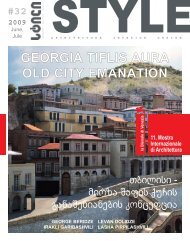Tbilisis haiat parki Hyatt Park Tbilisi siyvarulidan ... - Style Magazine
Tbilisis haiat parki Hyatt Park Tbilisi siyvarulidan ... - Style Magazine
Tbilisis haiat parki Hyatt Park Tbilisi siyvarulidan ... - Style Magazine
You also want an ePaper? Increase the reach of your titles
YUMPU automatically turns print PDFs into web optimized ePapers that Google loves.
serTificirebulia<br />
Ieoh Ming Pei<br />
Well-known American architect I.M.Pei, whose name invariably evokes an image<br />
of Louvre glass pyramid, became 90 years old this April.<br />
Pei was born in 1917 in Canton, China and passed his childhood and adolescence<br />
in Hong Kong, Shanghai and Suchou. At the age of 18, Pei went to the USA<br />
to study in Massachussetts Institute of Technology and then the Architectural Faculty<br />
of Harvard University. His teachers were Walter Gropius and Marcel Breuer, founders<br />
of Bauhaus.<br />
Architectural career of I.M.Pei was considerably influenced by his friendship with<br />
Kennedy family. In 1964, Pei was asked to develop a project of Kennedy Library in<br />
Boston. This was one of his first steps on the international architectural stage. Since<br />
that time, Pei designed 50 different projects on three continents – America, Asia and<br />
Europe, including high-rise constructions in Boston, Toronto, New York, Miami, Houston<br />
and Denver, Rafles City Tower in Singapore and a Christian church in Taiwan.<br />
In 1974, after a visit to China, Ieoh Ming Pei received an assignment from the<br />
Chinese government to design Xiangshan Hotel in the Fragrant Hills, former hunting<br />
grounds of the Chinese emperors. The realized construction with its asymmetric<br />
forms represents a modern interpretation of Chinese architectural and decoration<br />
traditions.<br />
On the next year, Pei started to design Bank of China office in Hong Kong.<br />
However, the most important works of Ieoh Ming Pei are East Wing of the National<br />
Gallery of Art in Washington, Louvre glass pyramid in Paris and Deutsches<br />
Historisches Museum in Berlin – museum projects, in which modern constructions<br />
are skilfully integrated into the existing historical context.<br />
Extension of Deutsches Historisches Museum – a transparent and dynamic, highly<br />
modern building, standing in the Classicist surroundings of Museuminsel, is the<br />
only project Ieoh Ming Pei realized in Germany. Deutsches Historisches Museum is<br />
a triangular stone-clad bulk with glazed entrance, featuring a spiral staircase. Fourlevel<br />
exhibition space, offering visitors new and unexpected perspectives, is connected<br />
with Baroque-style Zeughaus by an underground tunnel. Same as other proj-<br />
italiuri kafelis saloni<br />
misamarTi: <strong>Tbilisi</strong> 0179, i. abaSiZis q.#49. tel: (995 32) 23-36-77<br />
www.unifsp.ge<br />
stili #23. 2007<br />
ects, created by Pei, Deutsches Historisches Museum features expensive construction<br />
materials (e.g. the natural stone cladding, used on the facade) and refined interior<br />
design with rare lighting effects. The construction, specially designed for mobile<br />
exhibitions, is a masterpiece of urban planning.<br />
According to Pei, architecture is a pragmatic art, functioning only in case if all<br />
its components are in harmony with each other.<br />
In spite of his old age, Ieoh Ming Pei is as productive as ever. His most recent<br />
projects are museums in Luxembourg, Doha and Suchou.<br />
KETEVAN ODISHELI<br />
SPECIAL CORRESPONDENT FROM BERLIN<br />
webocementi<br />
izolacia<br />
santeqnika<br />
Semrevebi<br />
hidroabazanebi<br />
aveji da aqsesuarebi<br />
mosapirkeTebeli masalebi





